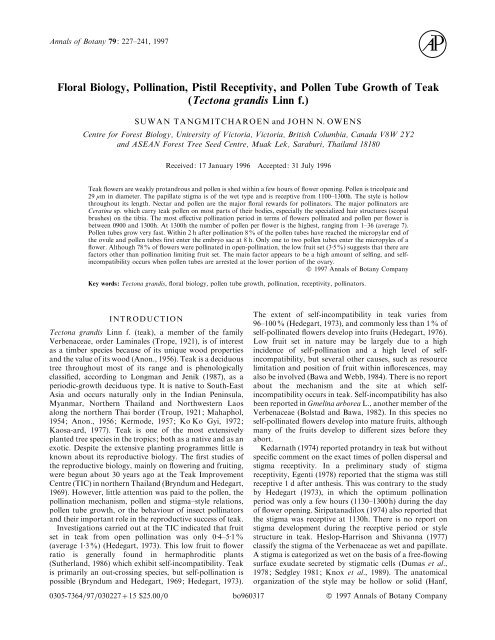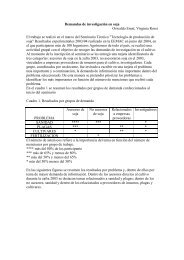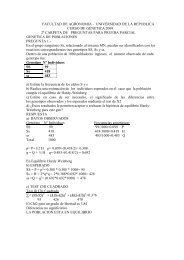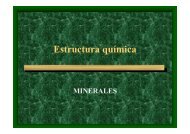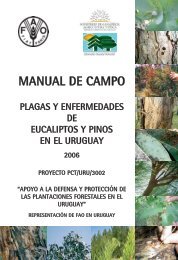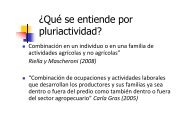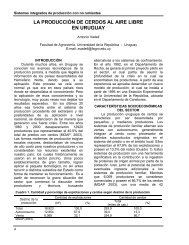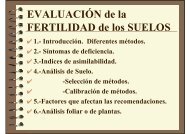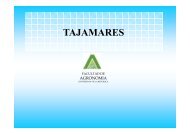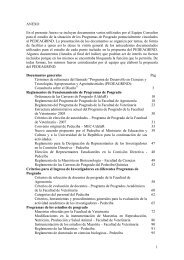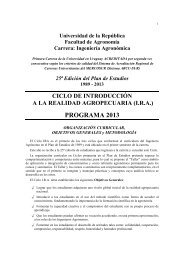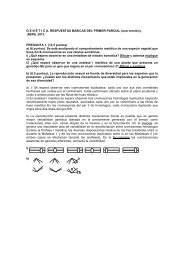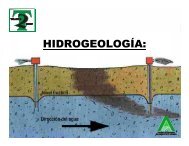Floral Biology, Pollination, Pistil Receptivity, and ... - Annals of Botany
Floral Biology, Pollination, Pistil Receptivity, and ... - Annals of Botany
Floral Biology, Pollination, Pistil Receptivity, and ... - Annals of Botany
You also want an ePaper? Increase the reach of your titles
YUMPU automatically turns print PDFs into web optimized ePapers that Google loves.
<strong>Annals</strong> <strong>of</strong> <strong>Botany</strong> 79: 227–241, 1997<br />
<strong>Floral</strong> <strong>Biology</strong>, <strong>Pollination</strong>, <strong>Pistil</strong> <strong>Receptivity</strong>, <strong>and</strong> Pollen Tube Growth <strong>of</strong> Teak<br />
(Tectona gr<strong>and</strong>is Linn f.)<br />
SUWAN TANGMITCHAROEN <strong>and</strong> JOHN N. OWENS<br />
Centre for Forest <strong>Biology</strong>, Uniersity <strong>of</strong> Victoria, Victoria, British Columbia, Canada V8W 2Y2<br />
<strong>and</strong> ASEAN Forest Tree Seed Centre, Muak Lek, Saraburi, Thail<strong>and</strong> 18180<br />
Received: 17 January 1996 Accepted: 31 July 1996<br />
Teak flowers are weakly prot<strong>and</strong>rous <strong>and</strong> pollen is shed within a few hours <strong>of</strong> flower opening. Pollen is tricolpate <strong>and</strong><br />
29 µm in diameter. The papillate stigma is <strong>of</strong> the wet type <strong>and</strong> is receptive from 1100–1300h. The style is hollow<br />
throughout its length. Nectar <strong>and</strong> pollen are the major floral rewards for pollinators. The major pollinators are<br />
Ceratina sp. which carry teak pollen on most parts <strong>of</strong> their bodies, especially the specialized hair structures (scopal<br />
brushes) on the tibia. The most effective pollination period in terms <strong>of</strong> flowers pollinated <strong>and</strong> pollen per flower is<br />
between 0900 <strong>and</strong> 1300h. At 1300h the number <strong>of</strong> pollen per flower is the highest, ranging from 1–36 (average 7).<br />
Pollen tubes grow very fast. Within 2 h after pollination 8% <strong>of</strong> the pollen tubes have reached the micropylar end <strong>of</strong><br />
the ovule <strong>and</strong> pollen tubes first enter the embryo sac at 8 h. Only one to two pollen tubes enter the micropyles <strong>of</strong> a<br />
flower. Although 78% <strong>of</strong> flowers were pollinated in open-pollination, the low fruit set (35%) suggests that there are<br />
factors other than pollination limiting fruit set. The main factor appears to be a high amount <strong>of</strong> selfing, <strong>and</strong> selfincompatibility<br />
occurs when pollen tubes are arrested at the lower portion <strong>of</strong> the ovary.<br />
1997 <strong>Annals</strong> <strong>of</strong> <strong>Botany</strong> Company<br />
Key words: Tectona gr<strong>and</strong>is, floral biology, pollen tube growth, pollination, receptivity, pollinators.<br />
INTRODUCTION<br />
Tectona gr<strong>and</strong>is Linn f. (teak), a member <strong>of</strong> the family<br />
Verbenaceae, order Laminales (Trope, 1921), is <strong>of</strong> interest<br />
as a timber species because <strong>of</strong> its unique wood properties<br />
<strong>and</strong> the value <strong>of</strong> its wood (Anon., 1956). Teak is a deciduous<br />
tree throughout most <strong>of</strong> its range <strong>and</strong> is phenologically<br />
classified, according to Longman <strong>and</strong> Jenik (1987), as a<br />
periodic-growth deciduous type. It is native to South-East<br />
Asia <strong>and</strong> occurs naturally only in the Indian Peninsula,<br />
Myanmar, Northern Thail<strong>and</strong> <strong>and</strong> Northwestern Laos<br />
along the northern Thai border (Troup, 1921; Mahaphol,<br />
1954; Anon., 1956; Kermode, 1957; Ko Ko Gyi, 1972;<br />
Kaosa-ard, 1977). Teak is one <strong>of</strong> the most extensively<br />
planted tree species in the tropics; both as a native <strong>and</strong> as an<br />
exotic. Despite the extensive planting programmes little is<br />
known about its reproductive biology. The first studies <strong>of</strong><br />
the reproductive biology, mainly on flowering <strong>and</strong> fruiting,<br />
were begun about 30 years ago at the Teak Improvement<br />
Centre (TIC) in northern Thail<strong>and</strong> (Bryndum <strong>and</strong> Hedegart,<br />
1969). However, little attention was paid to the pollen, the<br />
pollination mechanism, pollen <strong>and</strong> stigma–style relations,<br />
pollen tube growth, or the behaviour <strong>of</strong> insect pollinators<br />
<strong>and</strong> their important role in the reproductive success <strong>of</strong> teak.<br />
Investigations carried out at the TIC indicated that fruit<br />
set in teak from open pollination was only 04–51%<br />
(average 13%) (Hedegart, 1973). This low fruit to flower<br />
ratio is generally found in hermaphroditic plants<br />
(Sutherl<strong>and</strong>, 1986) which exhibit self-incompatibility. Teak<br />
is primarily an out-crossing species, but self-pollination is<br />
possible (Bryndum <strong>and</strong> Hedegart, 1969; Hedegart, 1973).<br />
The extent <strong>of</strong> self-incompatibility in teak varies from<br />
96–100% (Hedegart, 1973), <strong>and</strong> commonly less than 1% <strong>of</strong><br />
self-pollinated flowers develop into fruits (Hedegart, 1976).<br />
Low fruit set in nature may be largely due to a high<br />
incidence <strong>of</strong> self-pollination <strong>and</strong> a high level <strong>of</strong> selfincompatibility,<br />
but several other causes, such as resource<br />
limitation <strong>and</strong> position <strong>of</strong> fruit within inflorescences, may<br />
also be involved (Bawa <strong>and</strong> Webb, 1984). There is no report<br />
about the mechanism <strong>and</strong> the site at which selfincompatibility<br />
occurs in teak. Self-incompatibility has also<br />
been reported in Gmelina arborea L., another member <strong>of</strong> the<br />
Verbenaceae (Bolstad <strong>and</strong> Bawa, 1982). In this species no<br />
self-pollinated flowers develop into mature fruits, although<br />
many <strong>of</strong> the fruits develop to different sizes before they<br />
abort.<br />
Kedarnath (1974) reported prot<strong>and</strong>ry in teak but without<br />
specific comment on the exact times <strong>of</strong> pollen dispersal <strong>and</strong><br />
stigma receptivity. In a preliminary study <strong>of</strong> stigma<br />
receptivity, Egenti (1978) reported that the stigma was still<br />
receptive 1 d after anthesis. This was contrary to the study<br />
by Hedegart (1973), in which the optimum pollination<br />
period was only a few hours (1130–1300h) during the day<br />
<strong>of</strong> flower opening. Siripatanadilox (1974) also reported that<br />
the stigma was receptive at 1130h. There is no report on<br />
stigma development during the receptive period or style<br />
structure in teak. Heslop-Harrison <strong>and</strong> Shivanna (1977)<br />
classify the stigma <strong>of</strong> the Verbenaceae as wet <strong>and</strong> papillate.<br />
A stigma is categorized as wet on the basis <strong>of</strong> a free-flowing<br />
surface exudate secreted by stigmatic cells (Dumas et al.,<br />
1978; Sedgley 1981; Knox et al., 1989). The anatomical<br />
organization <strong>of</strong> the style may be hollow or solid (Hanf,<br />
0305-73649703022715 $25.000 bo960317 1997 <strong>Annals</strong> <strong>of</strong> <strong>Botany</strong> Company
228 Tangmitcharoen <strong>and</strong> Owens—<strong>Biology</strong>, <strong>Pollination</strong>, Receptiity <strong>and</strong> Pollen Tube Growth <strong>of</strong> Teak<br />
1936) but this is not known for teak. The stigma papillae<br />
<strong>and</strong> the transmitting tissue <strong>of</strong> both hollow <strong>and</strong> solid styles<br />
have secretory cells which produce the medium (Knox,<br />
1984) which guides the pollen tubes on their route from the<br />
stigma to the ovule (Weber, 1994).<br />
Many studies show that teak is insect-pollinated (Horne,<br />
1961; Cameron, 1968; Bryndum <strong>and</strong> Hedegart, 1969;<br />
Egenti, 1974; Kedarnath, 1974). Observations at the TIC<br />
indicated that two bee species, Ceratina hieroglyphica Sm.,<br />
<strong>of</strong> the Anthophoridae <strong>and</strong> Heriades binghami Dover (H.<br />
partula Bingham) <strong>of</strong> the Megachilidae are important teak<br />
pollinators. In Nigeria, Egenti (1981) found a relationship<br />
between fruit production <strong>and</strong> frequency <strong>of</strong> insect visits to<br />
teak flowers.<br />
It is evident that fruit production in teak is very low when<br />
compared to the abundance <strong>of</strong> flowers commonly produced.<br />
However, the causes <strong>of</strong> low fruit production are uncertain,<br />
in part because many aspects <strong>of</strong> the reproductive biology <strong>of</strong><br />
teak are unknown or incomplete. The purpose <strong>of</strong> the present<br />
study is to supply some <strong>of</strong> this missing information by<br />
reporting on teak flower structure <strong>and</strong> development during<br />
the prefertilization period, concentrating on the time <strong>of</strong><br />
receptivity, floral nectaries, development <strong>of</strong> the stigma<br />
papillae, insect visitations, the pollination mechanism<br />
including pollen deposition, pollen-tube growth <strong>and</strong> the site<br />
<strong>of</strong> incompatibility. Subsequent embryo, seed <strong>and</strong> fruit<br />
development <strong>and</strong> abortion are covered in another study<br />
from our laboratory (Palupi, 1996).<br />
MATERIALS AND METHODS<br />
Plant material <strong>and</strong> study site<br />
The study was conducted in 1992 at Muak-lek, Saraburi,<br />
Thail<strong>and</strong>, (14 40 N <strong>and</strong> 101 17 E) at about 200 m<br />
elevation. The daily mean maximum <strong>and</strong> minimum<br />
temperatures, <strong>and</strong> mean temperatures per month in 1990–<br />
1993 averaged 3221, 2097, <strong>and</strong> 2658 C, respectively. The<br />
relative humidity averaged 78% <strong>and</strong> the annual rainfall was<br />
1135 mm. Three T. gr<strong>and</strong>is trees were selected from a teak<br />
plantation based on accessibility, flowering performance<br />
<strong>and</strong> isolation. Scaffolding was erected to a height <strong>of</strong> 8 m<br />
around each tree. The study began in Jun. 1992 <strong>and</strong><br />
abundant flowers were produced during the Jun.–Aug.<br />
rainy season.<br />
Microscopy<br />
Specimens to be used for scanning electron microscopy<br />
(SEM) were fixed in formalin-acetic acid-alcohol (FAA)<br />
<strong>and</strong> subjected to a dehydration series to 100% ethanol.<br />
They were then critical-point dried, mounted on aluminum<br />
stubs, sputter-coated with gold <strong>and</strong> observed using a JEOL<br />
JS M-35 SEM at 15 kv. Specimens to be used for transmission<br />
electron microscopy (TEM) were fixed in 25%<br />
glutaraldehyde in 0075 m PO buffer (pH 72) for 2 h at<br />
<br />
room temperature, rinsed in 0075 m PO buffer, then<br />
<br />
postfixed in 1% osmium tetroxide for 1 h. Specimens were<br />
dehydrated in an ethanol series, infiltrated with Spurr’s<br />
resin (Spurr, 1969) <strong>and</strong> cured for 18 h at 60 C. Semithin<br />
sections (1 µm) for light microscopy (LM) were stained with<br />
Richardson’s stain (Richardson, Jarrett <strong>and</strong> Finke, 1960).<br />
Ultrathin sections were placed on uncoated 200-mesh copper<br />
grids, stained with 2% aqueous uranyl acetate <strong>and</strong> 02%<br />
lead citrate (Reynolds, 1963) <strong>and</strong> viewed with a JOEL JEM<br />
1200 EX electron microscope.<br />
Pollen structure <strong>and</strong> pollen shedding<br />
A flower was open <strong>and</strong> receptive for less than 1 d. On<br />
the day <strong>of</strong> receptivity, flowers in several inflorescences were<br />
tagged with coloured thread <strong>and</strong> anthers were periodically<br />
collected to examine morphological changes <strong>and</strong> to determine<br />
the period <strong>of</strong> pollen shedding. Both dehydrated <strong>and</strong><br />
hydrated pollen grains were examined using LM <strong>and</strong> SEM<br />
to determine pollen morphology. Dehydrated pollen grains<br />
were removed from the anthers <strong>and</strong> directly mounted on<br />
stubs, coated with gold, <strong>and</strong> observed using SEM. To<br />
measure pollen size, dehydrated pollen grains were dry<br />
mounted on glass slides. Hydrated pollen was fixed in FAA,<br />
rinsed with water <strong>and</strong> placed on a slide with a cover slip.<br />
Hydrated <strong>and</strong> unhydrated pollen grains were measured by<br />
means <strong>of</strong> an eyepiece micrometer using LM. Three hundred<br />
hydrated <strong>and</strong> unhydrated pollen grains from each <strong>of</strong> three<br />
trees were measured.<br />
<strong>Floral</strong> receptiity<br />
To determine the morphological changes <strong>of</strong> individual<br />
flowers during receptivity flowers were tagged with coloured<br />
thread, <strong>and</strong> fifteen flowers from each <strong>of</strong> five inflorescences<br />
from each <strong>of</strong> the three trees were collected at 4, 0, 4, 8, 12,<br />
16, 20, 24, 48, <strong>and</strong> 72 h from flower opening (0 h). Flowers<br />
were observed using a dissecting microscope <strong>and</strong> the<br />
characteristics were recorded. <strong>Pistil</strong>s during the early <strong>and</strong><br />
late receptive periods were stained with periodic acid Schiff’s<br />
reagent (PAS) modified from Pearse (1972) for localization<br />
<strong>of</strong> nectariferous tissue. To determine stigma receptivity<br />
flowers fixed in FAA were examined using the SEM, <strong>and</strong><br />
resin embedded sections were observed using LM <strong>and</strong> TEM<br />
procedures. The development <strong>of</strong> the stigma during the<br />
receptive period was observed.<br />
Insect isitors to flowers<br />
Using a h<strong>and</strong> net, the insects visiting teak flowers were<br />
collected for identification at 0800–1000h, 1000–1200h,<br />
1200–1400h <strong>and</strong> 1400–1600h for 8 d in Jul. Diversity,<br />
abundance, timing <strong>of</strong> visitation, <strong>and</strong> behaviour <strong>of</strong> insects<br />
were recorded. Collected insects were killed in a glass<br />
container containing cotton saturated with CCl <strong>and</strong> sent to<br />
<br />
the Entomology <strong>and</strong> Zoology Division, Ministry <strong>of</strong> Agriculture<br />
<strong>and</strong> Cooperatives, Bangkok, Thail<strong>and</strong> for identification.<br />
The identified insects were then examined under the<br />
dissecting microscope to assess their comparative efficiency<br />
for carrying pollen. To identify pollen on their bodies some<br />
insects <strong>of</strong> each species carrying pollen were examined using<br />
SEM at 15 kv.<br />
Monitoring <strong>of</strong> pollen tube growth<br />
To determine in io pollen tube growth, flowers that had<br />
been tagged <strong>and</strong> pollinated were collected at 14 different
Tangmitcharoen <strong>and</strong> Owens—<strong>Biology</strong>, <strong>Pollination</strong>, Receptiity <strong>and</strong> Pollen Tube Growth <strong>of</strong> Teak 229<br />
times (2, 4, 6, 8, 12, 16, 20, 24, 28, 32, 36, 40, 44 <strong>and</strong> 48 h)<br />
after each flower had become receptive (1100h). <strong>Pistil</strong>s were<br />
longitudinally sliced to remove the hairy lateral surfaces <strong>of</strong><br />
the ovary <strong>and</strong> fixed in ethanol-acetic acid (3:1 vv) for 24 h.<br />
After rinsing with water, pistils were cleared in 8n NaOH at<br />
room temperature for 2–4 d, or until most tissues became<br />
transparent. They were then rinsed in water <strong>and</strong> stained<br />
with 01% aniline blue in 01 K PO modified from Dumas<br />
<strong>and</strong> Knox (1983) <strong>and</strong> Kendrick <strong>and</strong> Knox (1985). The<br />
number <strong>of</strong> pollen tubes <strong>and</strong> the rate <strong>of</strong> pollen tube growth<br />
in the style were examined using fluorescence microscopy.<br />
To observe the penetration <strong>of</strong> pollen tubes, styles <strong>and</strong> the<br />
transmission tissue within were observed using a cry<strong>of</strong>racturing<br />
procedure modified from Tanaka (1989). Styles<br />
were excised as small pieces, fixed in 25% glutaraldehyde in<br />
0075 m PO buffer (pH 72) for 2 h at room temperature,<br />
rinsed in 0075 m PO buffer <strong>and</strong> placed in 10, 25, then 50%<br />
dimethyl sulfoxide (DMSO). They were then rapidly frozen<br />
with liquid nitrogen <strong>and</strong> cracked using liquid-nitrogenchilled<br />
forceps. The frozen tissues were immediately placed<br />
into 50% DMSO, rinsed in 0075 m PO buffer, placed in<br />
01% osmium tetroxide at 20 C for 1 d then postfixed with<br />
2% osmium tetroxide at 4 C for 3 h. They were then rinsed<br />
in water several times, dehydrated in an alcohol series,<br />
critical-point dried, coated with gold <strong>and</strong> observed with the<br />
SEM at 20 kv.<br />
Pollen production, pollination success, pollen–oule ratio<br />
<strong>and</strong> fruit set<br />
To determine the number <strong>of</strong> pollen grains per flower, one<br />
mature anther per flower was removed from five unopened<br />
flowers from five inflorescences from each <strong>of</strong> two trees.<br />
Anthers were gently squashed on a 1 mm graticule slide,<br />
stained with aceto-carmine, covered with a 12 mm circular<br />
coverslip <strong>and</strong> pollen grains were counted. To determine the<br />
number <strong>of</strong> pollen grains per stigma, stigmas were removed<br />
from flowers tagged at flower opening <strong>and</strong> stained with<br />
aceto-carmine at 0, 2, 4, 6, 8 h after flower opening.<br />
<strong>Pollination</strong> success was calculated as the percentage <strong>of</strong><br />
pollinated flowers. The pollen–ovule ratios were determined<br />
by dividing the average number <strong>of</strong> pollen grains per flower<br />
by the average number <strong>of</strong> ovules per flower. <strong>Pollination</strong><br />
efficiency was determined by dividing the number <strong>of</strong> pollen<br />
grains per stigma by the number <strong>of</strong> pollen grains produced<br />
per flower. To determine fruit set, ten inflorescences from<br />
each <strong>of</strong> three trees were flagged <strong>and</strong> the number <strong>of</strong> flowers<br />
at pollination <strong>and</strong> the number <strong>of</strong> fruits remaining 2 months<br />
after pollination were counted.<br />
Statistical analysis<br />
Meansthe st<strong>and</strong>ard error <strong>of</strong> the mean were calculated<br />
for all measurements. Arc-sine transformations were applied<br />
to the percentage <strong>of</strong> fruit set <strong>and</strong> the percentage <strong>of</strong> pollinated<br />
flowers before analysis <strong>of</strong> variance (ANOVA) was carried<br />
out. The among tree variation in pollen size, the number <strong>of</strong><br />
pollen grains per flower, pollination success, <strong>and</strong> fruit set<br />
were assessed by ANOVA. The Duncan new multiple range<br />
test at P 005 was used to compare the means if there was<br />
a significant difference among the variables.<br />
RESULTS<br />
<strong>Floral</strong> morphology<br />
Teak flowers are hermaphroditic <strong>and</strong> arranged in large<br />
panicles containing 2700240 (n 30) flowers. There was<br />
a highly significant difference in number <strong>of</strong> flowers per<br />
inflorescence among trees (P 0001). Only 1–3% <strong>of</strong> the<br />
flowers in an inflorescence bloom each day, thus blooming<br />
took 1–2 months for the entire inflorescence, depending on<br />
its size. The actinomorphic flowers have six whitish petals<br />
making up a corolla with a diameter <strong>of</strong> 631 mm007 (n <br />
30). The lower half <strong>of</strong> the corollas are undivided forming a<br />
tube to which six stamens are attached (Fig. 1).<br />
Each anther has two microsporangia, each bearing two<br />
chambers (Figs 2 <strong>and</strong> 3). The epidermal cells <strong>of</strong> the mature<br />
anther exp<strong>and</strong> (Fig. 2) <strong>and</strong>, based on cry<strong>of</strong>ractured<br />
specimens, appear to contain secretory substances (Fig. 4).<br />
The pistil has a long (655 mm011, n 31), narrow<br />
bifurcate style <strong>and</strong> a hairy ovary containing four ovules.<br />
The forked stigma (Fig. 10) is <strong>of</strong> the wet papillate type with<br />
unicellular papillae (Figs 5 <strong>and</strong> 18). Transmitting tissue is <strong>of</strong><br />
the hollow type (Fig. 6) <strong>and</strong> extends from the cell beneath<br />
the papillae <strong>of</strong> the stigma (Fig. 19) to the loculi (Fig. 28).<br />
Pollen shedding <strong>and</strong> pollen structure<br />
Approximately 1 h after the flower opens cells along the<br />
sides <strong>of</strong> the anthers break down forming a slit. As the<br />
anthers are moved by wind or brushed by insects, mature<br />
pollen is released (Fig. 4). An anther contains 2100170 (n<br />
10) pollen grains. Some pollen remains in the anther for<br />
approx. 3 h after anther opening (0800–1100h). Pollen<br />
dispersal increased in wind. Anthers began to become<br />
brown with a bent filament at 1500h <strong>and</strong> collapsed by<br />
1700h.<br />
Pollen is medium tricolpate, but varies somewhat in size<br />
<strong>and</strong> shape (Table 1) depending on the amount <strong>of</strong> hydration.<br />
Dehydrated pollen is semiangular, ranging in size from<br />
12–29 µm (µ20 µm) as seen in polar view, <strong>and</strong> oval,<br />
perprolate to prolate, ranging in size from 2424–48 µm<br />
(µ 40 µm) in equatorial view. Shortly after l<strong>and</strong>ing on<br />
the stigma, pollen hydrates <strong>and</strong> exp<strong>and</strong>s. Hydrated pollen is<br />
spherical to oblate or suboblate in both polar <strong>and</strong> equatorial<br />
views, <strong>and</strong> ranges in size from 168–36 µm (µ29 µm).<br />
There was a highly significant difference among trees (P <br />
0001) in size, in both polar <strong>and</strong> equatorial views <strong>of</strong><br />
dehydrated pollen, but no significant difference in diameter<br />
<strong>of</strong> hydrated pollen. Pollen coat substances (pollen kitt) were<br />
occasionally found on the maturing teak pollen surface, in<br />
particular on pollen collected during the early receptive<br />
period. The degree <strong>of</strong> hydration had no influence on pollen<br />
germination; poorly <strong>and</strong> highly hydrated pollen (based on<br />
size <strong>and</strong> shape) germinated <strong>and</strong> produced pollen tubes (Fig.<br />
5).
230 Tangmitcharoen <strong>and</strong> Owens—<strong>Biology</strong>, <strong>Pollination</strong>, Receptiity <strong>and</strong> Pollen Tube Growth <strong>of</strong> Teak<br />
Fig. 1. Teak (Tectona gr<strong>and</strong>is) flowers, showing six stamens <strong>and</strong> petals <strong>and</strong> straight style at receptivity (A); <strong>and</strong> (B) 1 d after receptivity after<br />
the corolla abscised. Bar 5 mm. Figs 2–4. Scanning electron micrographs (SEM) <strong>of</strong> mature anthers <strong>of</strong> Tectona gr<strong>and</strong>is. Fig. 2. Longitudinal<br />
view <strong>of</strong> the partially open anther at 1300h, showing swelling <strong>of</strong> the epidermal cells which appear to contain secretory substances. Bar 04 mm.<br />
Fig. 3. Transverse section <strong>of</strong> anther as in Fig. 2 showing two microsporangia, each bearing two chambers. Bar 03 mm. Fig. 4. Inside <strong>of</strong> dehisced<br />
anther showing pollen <strong>and</strong> the secretion (*). Bar 004 mm. Fig. 5. SEM <strong>of</strong> stigma papillae during receptivity with germinated pollen showing<br />
varying degrees <strong>of</strong> hydration. Pollen tubes appear to have entered between the loose papillae. Bar 50 µm. Figs 6–8. Light micrographs <strong>of</strong><br />
longitudinal sections <strong>of</strong> floral nectaries stained with periodic acid-Schiffs. Fig. 6. <strong>Floral</strong> nectaries at the base <strong>of</strong> the ovary. Bar 04 mm. Fig. 7.<br />
Nectariferous tissue during the pre-receptive period characterized by darkly staining cells containing large amounts <strong>of</strong> starch (arrowhead). Bar<br />
003 mm. Fig. 8. Nectariferous tissue during post-receptive period. Starch has been hydrolyzed leaving large vacuolate cells. Bars 003 mm.<br />
Figs 9 <strong>and</strong> 10. SEM micrographs during receptivity when style is relatively straight. Fig. 9. Forked stigma but lobes remain together. Bar <br />
03 mm. Fig. 10. Splayed stigma. Bar 03 mm. P, pollen; EP, epidermal cell; M, microsporangia; PT, pollen tubes; NE, nectary; SY, style; TT,<br />
hollow transmitting tissue; OV, ovule; ST, stigma.<br />
Receptiity <strong>and</strong> stigma deelopment<br />
The phenology <strong>of</strong> individual teak flowers during the day<br />
<strong>of</strong> receptivity is shown in Table 2. Individual flowers are<br />
weakly prot<strong>and</strong>rous with anthers starting to dehisce at<br />
0800h, approx. 3 h before peak stigma receptivity begins<br />
(1100h) <strong>and</strong> when the corolla is completely open. The bent<br />
style is the first organ to emerge. It extends fully between
Tangmitcharoen <strong>and</strong> Owens—<strong>Biology</strong>, <strong>Pollination</strong>, Receptiity <strong>and</strong> Pollen Tube Growth <strong>of</strong> Teak 231<br />
Figs 11–16. Scanning electron micrographs (SEM) <strong>of</strong> Tectona gr<strong>and</strong>is stigmas. Fig. 11. Pre-receptive stigma at 0900h. Bar 60 µm. Fig. 12.<br />
Receptive stigma at 1300h showing some exudate. Bar 60 µm. Fig. 13. Post-receptive stigma with pollen adhering at 1500h. Papillae are starting<br />
to dry <strong>and</strong> collapse. Bar 60 µm. Fig. 14. Incompletely exp<strong>and</strong>ed papillae <strong>of</strong> pre-receptive stigma. Bar 10 µm. Fig. 15. Turgid papillae <strong>of</strong><br />
receptive stigma showing spaces (arrowhead) between. Bar 10 µm. Fig. 16. Degenerating papillae <strong>of</strong> post-receptive stigma showing collapsed<br />
papillae <strong>and</strong> large spaces between which contain remnants <strong>of</strong> exudate (arrowheads). Bar 10 µm. Figs 17–19. Light micrographs <strong>of</strong> longitudinal<br />
sections <strong>of</strong> stigmas as shown in Figs 11–13. Fig. 17. Pre-receptive stigma showing enlarging unicellular papillae. Bar 60 µm. Fig. 18. Receptive<br />
stigma showing papillae with pericytoplasmic spaces (arrowhead) <strong>and</strong> beginning <strong>of</strong> hollow transmitting tissue. Bar 60 µm. Fig. 19. Postreceptive<br />
stigma showing collapsing papillae with space below (arrowhead) <strong>and</strong> adhering pollen. PA, papillae; E, exudate; P, pollen; TT, hollow<br />
transmitting tissue; SA, space.<br />
1100h <strong>and</strong> 1300h <strong>and</strong> exceeds the length <strong>of</strong> the anthers (Fig.<br />
1). The corolla begins to abscise at about 1900h, or earlier in<br />
windy conditions. About 95% <strong>of</strong> the flowers shed the<br />
corolla by 2300h.<br />
Nectar appears from 0500h to 1700h in the lower half <strong>of</strong><br />
the corolla where the floral tube forms. Sectioned pistils<br />
stained with PAS show many floral nectaries located around<br />
the base <strong>of</strong> the ovary (Fig. 6). Cells in nectariferous tissue<br />
during the pre-receptive period had dense cytoplasm with<br />
large amounts <strong>of</strong> starch (Fig. 7). The starch hydrolyzed <strong>and</strong><br />
disappeared during the receptive period leaving large<br />
vacuolate cells (Fig. 8).<br />
It is difficult to determine the receptive period by the<br />
shape <strong>of</strong> the style, which remained relatively straight during
232 Tangmitcharoen <strong>and</strong> Owens—<strong>Biology</strong>, <strong>Pollination</strong>, Receptiity <strong>and</strong> Pollen Tube Growth <strong>of</strong> Teak<br />
Table 1. Tectona gr<strong>and</strong>is pollen size <strong>and</strong> shape before <strong>and</strong> after hydration in polar <strong>and</strong> equatorial iew<br />
Polar view Equatorial view<br />
Pollen type size (µm) shape size (µm) shape<br />
Dehydrated (n 900) 1994014 semiangular 3979035 oval-prolate to perprolate<br />
Hydrated (n 900) 2884012 circular same as polar view circular-oblate to suboblate<br />
Table 2. The phenology <strong>of</strong> indiidual Tectona gr<strong>and</strong>is<br />
flowers during the day <strong>of</strong> receptiity<br />
Time <strong>of</strong> day Events<br />
0400h flower closed, style coiled<br />
0500h nectar appears<br />
0700h flower opens<br />
0800h anthers open<br />
1100h–1300h peak receptive period<br />
– corolla completely open<br />
– style straight<br />
– stigma reflexed <strong>and</strong> turgid<br />
– hydration <strong>of</strong> pollen on stigma<br />
1500h post-receptive<br />
– stigma tip dry <strong>and</strong> collapsed<br />
1700h anthers collapse, nectar disappears<br />
1900h corolla begins to shed<br />
the day <strong>of</strong> receptivity, or the stigma between the pre- <strong>and</strong><br />
post-receptive periods in which the two forks may stick<br />
together (Fig. 9) or splay (Fig. 10). However, there were<br />
some morphological changes in the papillate stigma. During<br />
the pre-receptive period, the stigma enlarged slightly but<br />
papillae did not exp<strong>and</strong> completely (Figs 11, 14 <strong>and</strong> 17) <strong>and</strong><br />
some remained relatively wrinkled. During the receptive<br />
period, from approx. 1100h to 1300h, the stigma enlarged,<br />
papillae became more turgid (Figs 12, 15 <strong>and</strong> 18), secretions<br />
were occasionally seen on the surface <strong>and</strong> some papillae had<br />
pericytoplasmic spaces where secretions may be present<br />
(Fig. 18). During the post-receptive period, the stigma<br />
turned dark-yellow <strong>and</strong> dry, <strong>and</strong> papillae became wrinkled<br />
<strong>and</strong> collapsed (Figs 13, 16 <strong>and</strong> 19). Remnants <strong>of</strong> the exudate<br />
were found on some stigmas (Fig. 16).<br />
Insect isitors to flowers<br />
Thirty-seven insect species belonging to the Hymenoptera,<br />
Diptera, Lepidoptera, Hemiptera <strong>and</strong> Coleoptera were<br />
collected from teak inflorescences during eight observation<br />
days (Table 3). Most were observed in the morning<br />
(0900h–1100h). Flies <strong>and</strong> bees, particularly the small<br />
carpenter bees (Ceratina sp.), were the most common insects<br />
found; they foraged for pollen <strong>and</strong> nectar all day. The<br />
number <strong>of</strong> pollen grains on insect bodies was quite variable<br />
among insect groups. Generally only Diptera <strong>and</strong> Hymenoptera<br />
had pollen on their bodies, <strong>and</strong> Hymenoptera had<br />
more pollen. Lepidoptera (butterflies) <strong>and</strong> Formicidae (ants)<br />
played little or no part in the transfer <strong>of</strong> teak pollen. The<br />
SEM study revealed pollen other than teak on the long<br />
proboscis <strong>of</strong> butterflies.<br />
Ceratina sp. had the highest pollen loads <strong>and</strong> pollen<br />
grains on all parts <strong>of</strong> their hairy bodies. They collected<br />
pollen by foraging on several newly open flowers in one<br />
inflorescence <strong>and</strong> travelled among inflorescences <strong>and</strong> trees.<br />
However, most tended to forage <strong>and</strong> stay on the same tree<br />
for a long period <strong>of</strong> time. Heavy pollen loads were also<br />
located on their legs, particularly on the specialized, dense<br />
scopal hairs <strong>of</strong> the tibia <strong>and</strong> tarsus (Fig. 20). In addition to<br />
teak pollen, other pollen (Acacia. sp) was occasionally<br />
present (Fig. 21). SEM studies revealed a rough surface on<br />
the pollen exine (Fig. 22) <strong>and</strong> long-hairs <strong>of</strong> the tibia (Fig. 21)<br />
which may enhance pollen deposition on the insect bodies.<br />
Ceratina sp. had no sticky substances on their bodies.<br />
Most honey bees (Apis mellifera) visiting teak flowers<br />
carried foreign pollen; however, they occasionally carried<br />
teak pollen on their hind legs, especially the tibia (Fig. 23).<br />
Unlike carpenter bees, honey bees have a pollen moistening<br />
behaviour. Pollen, once collected, became hydrated <strong>and</strong><br />
exp<strong>and</strong>ed (Fig. 24). The sticky substances may cause pollen<br />
to accumulate on their hind legs but would not allow<br />
effective pollen transfer.<br />
Pathway <strong>of</strong> pollen tubes <strong>and</strong> rate <strong>of</strong> pollen-tube growth<br />
The pathway <strong>of</strong> pollen-tube growth to the embryo sac is<br />
shown in Fig. 28. Pollen l<strong>and</strong>ing on the stigma quickly<br />
hydrates <strong>and</strong> pollen tubes emerge from the pollen aperture<br />
adjacent to the stigma surface within 2 h. Pollen tubes pass<br />
through the intercellular spaces between papillae (Fig. 5)<br />
then grow along the surface <strong>of</strong> the hollow transmitting<br />
tissues (Figs 25–27) <strong>of</strong> the style. In the transmitting tissue,<br />
pollen tubes vary in width <strong>and</strong> number <strong>of</strong> callose plugs (Figs<br />
29 <strong>and</strong> 30). Callose plugs usually form sporadically in the<br />
pollen tube all along the style length (Figs 29 <strong>and</strong> 30). As a<br />
result the intensity <strong>of</strong> pollen tube <strong>and</strong> callose plug<br />
fluorescence varies among pollen tubes <strong>and</strong> along the style<br />
length. Pollen tubes at the upper part <strong>of</strong> the style lose<br />
fluorescence while tubes in the lower part still fluoresce.<br />
Abnormalities <strong>of</strong> pollen-tube growth such as me<strong>and</strong>ering<br />
tubes, irregular tubes, forked <strong>and</strong> swollen tips (Fig. 30) were<br />
found for most collection times. Abnormalities may occur<br />
anywhere along the style length but are more common in the<br />
lower portion <strong>of</strong> the style. Most pollen tubes grow through<br />
the style <strong>and</strong> reach an ovule. A few become arrested in the<br />
lower portion <strong>of</strong> the ovary (Figs 31 <strong>and</strong> 32) <strong>and</strong> only 1–2<br />
pollen tubes per flower reach an embryo sac (Figs 33–35).
Tangmitcharoen <strong>and</strong> Owens—<strong>Biology</strong>, <strong>Pollination</strong>, Receptiity <strong>and</strong> Pollen Tube Growth <strong>of</strong> Teak 233<br />
Table 3. Insect isitors to Tectona gr<strong>and</strong>is flowers collected at ASEAN Forest Tree Seed Centre, Saraburi, Thail<strong>and</strong> during<br />
8 obseration d in July<br />
Insect visitors<br />
Order<br />
Family Species<br />
Relative*<br />
amount <strong>of</strong><br />
teak pollen<br />
insect<br />
Estimated†<br />
number <strong>of</strong><br />
insects<br />
observed<br />
Time <strong>of</strong><br />
visitation<br />
Hymenoptera<br />
Anthophoridae Ceratina sp. 4 3 0800h–1700h<br />
Vespidae Polistes sp. 2 2 1000h–1400h<br />
Polistes sagitarrius Sauss. 2 2 1000h–1200h<br />
Polistes stigma Fabr. 2 2 1000h–1200h<br />
Vespa affinis (L.) 2 2 0800h–1000h<br />
Vespa elutina Lepeltier 2 2 1200h–1400h<br />
Formicidae — 0 1 1000h–1600h<br />
Apidae Apis mellifera 3 2 0800h–1200h<br />
Eumennidae Eumenes conica Fabricius. 2 2 1400h–1600h<br />
Eumennes esuriens Fabricius. 2 2 1400h–1600h<br />
Eumenes orchitectus Smith. 2 2 1400h–1600h<br />
Eumenes petiolata Fabricius. 2 2 1400h–1600h<br />
Diptera<br />
Eumenes sp. 2 2 1200h–1600h<br />
Calliphoridae Stomorhina lunata (Fab.) 1 4 0800h–1700h<br />
Lucilia sp. 1 3 1000h–1600h<br />
Tachinidae Dolichocolon sp. 1 3 1000h–1600h<br />
Sarcophagidae Sarcophaga sp. 1 3 1000h–1600h<br />
Syrphidae Eristalinus arorum (Fab.) 1 2 1000h–1600h<br />
Otitidae<br />
Lepidoptera<br />
Chrysomyza sp. 1 2 1000h–1600h<br />
Hesperidae Iambrix salsala salsala Moore. 0 1 1400h–1600h<br />
Oriens sp. 0 1 1400h–1600h<br />
Pelopides sp. 0 1 1400h–1600h<br />
Lycaenidae Euchrysops paudaa Horsf. 0 1 1400h–1600h<br />
Nacaduba sp. 0 1 1400h–1600h<br />
Nymphalidae Naptis columella martabana Moore. 0 1 1000h–1600h<br />
Precis almana almana (L.). 0 1 1400h–1600h<br />
Papilionidae Precis lemonias L. 0 2 1000h–1200h<br />
Atrophaneura aristolochiae aristolochiae Fabr. 0 1 0800h–1600h<br />
Pieridae Catopsilia pomona pomona-f hilaria stoll. 0 1 1400h–1600h<br />
Catopsilia pomona pomona-f pomona Fabr. 0 1 1200h–1400h<br />
Satyridae Delias hyparate ciris Fruhst. 1 1 0800h–1000h<br />
Eurema sp. 1 2 0800h–1200h<br />
Symtomidae Ypthima baldus baldus Fabr. 0 1 1400h–1600h<br />
Hemiptera Ypthima sp. 0 1 1400h–1600h<br />
Flatidae<br />
Membracidae<br />
Amata Sperbius Fabr. 0 2 1000h–1600h<br />
Coleoptera<br />
Scarabaeidae<br />
— 0 1 1400h–1600h<br />
Tricentrus sp. 0 1 1400h–1600h<br />
Glycyphana horsfiedi Hope. 0 1 1200h–1600h<br />
* Relative amount <strong>of</strong> teak pollen per insect; 0, none; 1, very few grains (individual pollen grains periodically scattered on the bodies <strong>of</strong> insects);<br />
2, few grains (small numbers <strong>of</strong> pollen grains can be found individually or in small clusters); 3, many pollen grains (pollen grains found in clusters);<br />
4, abundant (clusters <strong>and</strong> individual pollen grains are noticeable even with the naked eye).<br />
† General range <strong>of</strong> number <strong>of</strong> insects observed: 1, occasional (1–4); 2, low (5–10); 3, medium (15–25); 4, high (55–65 or almost always present).<br />
The rates <strong>of</strong> pollen-tube growth in open pollinated<br />
flowers after the start <strong>of</strong> the receptive period (1100h) are<br />
shown in Fig. 36. Over 90% <strong>of</strong> pollen tubes penetrate<br />
between papillae. At 2 h after pollination, 8% <strong>of</strong> the pollen<br />
tubes reach the micropylar end <strong>of</strong> the ovule. There is little<br />
pollen-tube growth between 2 <strong>and</strong> 6 h after pollination.<br />
Pollen tubes first appear in embryo sacs (106%069) at<br />
8 h. At 12 h, approx. 62% <strong>of</strong> the pollen tubes reach an<br />
ovule <strong>and</strong> 30% reach the lower portion <strong>of</strong> the ovary. At 24 h,<br />
approx. 70% <strong>of</strong> pollen tubes reach an ovule, or the lower<br />
portion <strong>of</strong> the ovary. Over 40% <strong>of</strong> the pollen tubes enter<br />
into a micropyle, but only 3–8% grow to an embryo sac.<br />
<strong>Pollination</strong> success <strong>and</strong> pollen–oule ratio<br />
The number <strong>of</strong> pollen grains reaching the stigma<br />
(pollination success) gradually increased during the day <strong>of</strong><br />
receptivity. There were highly significant differences (P <br />
0001) in the number <strong>of</strong> pollen grains l<strong>and</strong>ing on the stigma,<br />
both among trees, <strong>and</strong> at different times during the day <strong>of</strong>
234 Tangmitcharoen <strong>and</strong> Owens—<strong>Biology</strong>, <strong>Pollination</strong>, Receptiity <strong>and</strong> Pollen Tube Growth <strong>of</strong> Teak<br />
Figs 20–22. SEM micrographs <strong>of</strong> pollen on tibia <strong>of</strong> carpenter bee (Caratina sp.). Fig. 20. Teak pollen carried by the specialized dense scopal hairs.<br />
Bar 01 mm. Fig. 21. Close-up showing dry teak <strong>and</strong> Acacia pollen among scopal hairs. Bar 40 µm. Fig. 22. Close-up showing rough exine<br />
on an unhydrated teak pollen <strong>and</strong> a scopal hair without sticky substances. Bar 5 µm. Figs 23–24. SEMs <strong>of</strong> teak pollen on honey bee (Apis<br />
mellifera) tibia. Fig. 23. Teak pollen adhering to tibia with sticky substances. Bar 02 mm. Fig. 24. Close-up <strong>of</strong> hydrated pollen adhering to<br />
corbiculae <strong>of</strong> tibia with sticky substances. Bar 15 µm. Figs 25–27. Cryo-SEMs <strong>of</strong> transversely sectioned mid-portions <strong>of</strong> mature styles at 1300h<br />
on the day <strong>of</strong> receptivity. Fig. 25. Style <strong>of</strong> unpollinated flower showing the empty stylar canal. Bar 02 mm. Fig. 26. Style <strong>of</strong> pollinated flower<br />
showing several pollen tubes (arrowhead) in the canal. Bar 02 mm. Fig. 27. Close-up <strong>of</strong> pollen tubes in Fig. 26 showing remnants <strong>of</strong> secretions<br />
(arrowheads). Bar 10 µm. AP, Acacia pollen; P, teak pollen; SP, scopal hair; SS, sticky substances; ST, style; TT, hollow transmitting tissue;<br />
PT, pollen tube.<br />
receptivity (Fig. 37). About 7% <strong>of</strong> flowers were pollinated<br />
at the time <strong>of</strong> flower opening (0700h) but there was only<br />
about one pollen grain per pollinated flower. There was a<br />
significant increase in pollinated flowers from 0700h to<br />
0900h when approx. 50% <strong>of</strong> flowers were pollinated <strong>and</strong><br />
from 0900h to 1300h when approx. 80% <strong>of</strong> flowers were<br />
pollinated. The number <strong>of</strong> pollen grains per stigma varied<br />
among trees (P 0001), <strong>and</strong> increased significantly (P <br />
0001) from 0700h to 1100h when there were about three<br />
grains per stigma, <strong>and</strong> from 1100h to 1300h when there were
Tangmitcharoen <strong>and</strong> Owens—<strong>Biology</strong>, <strong>Pollination</strong>, Receptiity <strong>and</strong> Pollen Tube Growth <strong>of</strong> Teak 235<br />
Figs 28–32. Epi-fluorescence micrographs <strong>of</strong> open-pollinated pistils 24 h following pollination. <strong>Pistil</strong>s were stained with decolourized aniline blue<br />
to localize callose. Fig. 28. <strong>Pistil</strong> showing pathway <strong>of</strong> pollen tubes from style to ovules. Pollen tubes in the lower half <strong>of</strong> the style stain more<br />
intensely for callose <strong>and</strong> callose plugs. Bar 1 mm. Fig. 29. Close-up <strong>of</strong> stigma from Fig. 28 showing entrance <strong>of</strong> pollen tubes into the stylar canal<br />
shortly after pollination. Bar 025 mm. Fig. 30. Close up <strong>of</strong> pollen tubes in the upper half <strong>of</strong> the style. Intensity <strong>of</strong> fluorescence shows variation<br />
in size <strong>of</strong> pollen tubes, amount <strong>of</strong> callose, <strong>and</strong> swelling <strong>of</strong> tube tip in the stylar canal. Bar 005 mm. Fig. 31. Arrested pollen tubes with tapered<br />
tips <strong>and</strong> faint fluorescence in the upper portion <strong>of</strong> the ovary. Bar 005 mm. Fig. 32. Arrested pollen tubes in the lower portion <strong>of</strong> the ovary.<br />
Bar 01 mm. Figs 33–35. Pollen tubes entering the embryo sac about 24 h after pollination. Fig. 33. Fluorescence micrograph showing pollen<br />
tubes near the micropyle (arrow) with only one tube growing towards the embryo sac (arrowhead). Bar 007 mm. Fig. 34. Light micrograph<br />
showing pollen tube entering the micropyle. Bar 007 mm. Fig. 35. Transmission electron micrograph showing the micropylar region <strong>of</strong> the<br />
ovule shown in Fig. 34. Bar 5 µm. ST, stigma; SY, style; O, ovary; OV, ovule; P, pollen; PT, pollen tubes; SW, swelling tip; EM, embryo<br />
sac; OW, ovary wall.<br />
about six grains per stigma. There was no significant<br />
increase in the number <strong>of</strong> pollen grains per stigma after<br />
1300h. Therefore, the most effective pollination period was<br />
between 0900h <strong>and</strong> 1300h in terms <strong>of</strong> flowers pollinated <strong>and</strong><br />
the number <strong>of</strong> pollen grains per flower. At 1300h approx.<br />
80% <strong>of</strong> flowers were pollinated <strong>and</strong> on average there were<br />
seven pollen grains per stigma.<br />
The mean number <strong>of</strong> pollen grains produced per flower<br />
was 130001100 (n 10). There was no significant<br />
difference in the number <strong>of</strong> pollen grains produced per
236 Tangmitcharoen <strong>and</strong> Owens—<strong>Biology</strong>, <strong>Pollination</strong>, Receptiity <strong>and</strong> Pollen Tube Growth <strong>of</strong> Teak<br />
Distance through style<br />
em<br />
mc<br />
ov<br />
100%<br />
75%<br />
50%<br />
25%<br />
em<br />
mc<br />
ov<br />
100%<br />
75%<br />
50%<br />
25%<br />
0<br />
2 h<br />
8 h<br />
20 40 60<br />
12 h<br />
24 h<br />
80 100 0 20 40 60 80 100<br />
Percentage <strong>of</strong> pollen tubes<br />
Fig. 36. Percentage <strong>of</strong> pollen tubes at different positions in the pistil at 2 h (n 10), 8 h (n 65), 12 h (n 36), <strong>and</strong> 24 h (n 24) after the start<br />
<strong>of</strong> the receptive period (1100h). Horizontal lines represent the st<strong>and</strong>ard error. 25%, 50%, 75%, <strong>and</strong> 100% refer to percent <strong>of</strong> the style length;<br />
ov, ovule; mc, micropyle; em, embryo sac.<br />
Number <strong>of</strong> pollen grains on stigma<br />
10<br />
8<br />
6<br />
4<br />
2<br />
0<br />
a<br />
a'<br />
0700<br />
ab<br />
b'<br />
b<br />
0900 1100<br />
Time <strong>of</strong> day<br />
1300<br />
1500<br />
100<br />
Fig. 37. Mean number <strong>of</strong> pollen grains per the stigma () <strong>of</strong> openpollinated<br />
flowers <strong>and</strong> mean percentage <strong>of</strong> pollinated flowers () on<br />
the day <strong>of</strong> receptivity on 60 flowers from each <strong>of</strong> three trees. Along a<br />
line, means <strong>of</strong> each variable shown by the same letter are not<br />
significantly different at P 005 as determined by Duncan’s new<br />
multiple range test. Vertical bars represent st<strong>and</strong>ard errors.<br />
b'c'<br />
c<br />
c'<br />
c<br />
b'c'<br />
80<br />
60<br />
40<br />
20<br />
0<br />
% <strong>of</strong> pollinated flowers<br />
flower. All pollen was shed from a flower in one day. Two<br />
days after the day <strong>of</strong> receptivity, unpollinated flowers<br />
abscise. The pollen-ovule ratio was 32531, <strong>and</strong> the<br />
percentage <strong>of</strong> fruit set was 351028 (n 30). There were<br />
highly significant differences among trees (P 0001) in<br />
these parameters.<br />
DISCUSSION<br />
<strong>Floral</strong> morphology <strong>and</strong> receptiity<br />
Teak has a hermaphroditic flower with little spatial <strong>and</strong><br />
temporal separation <strong>of</strong> male <strong>and</strong> female functions; the style<br />
slightly exceeds the length <strong>of</strong> the anthers <strong>and</strong> the anthers<br />
begin to dehisce 3 h before peak stigma receptivity.<br />
Prot<strong>and</strong>ry makes it possible for most pollen to be dispersed<br />
before the papillate stigma becomes most receptive. Prot<strong>and</strong>ry<br />
occurs frequently in outcrossing angiosperms (Stout,<br />
1928; Garnock-Jones <strong>and</strong> Malloy, 1982; Lloyd <strong>and</strong> Webb,<br />
1986; Dudash, 1990) <strong>and</strong> is assumed to be a common<br />
method selected for avoidance <strong>of</strong> self-fertilization (Richards,<br />
1994). Lloyd <strong>and</strong> Webb (1986) reported that prot<strong>and</strong>ry may<br />
also serve to prolong pollen presentation, avoid pollenstigma<br />
interference, <strong>and</strong> optimally position pollen for<br />
dispatch <strong>and</strong> reception. In teak, however, the prot<strong>and</strong>rous<br />
flowers still allow self-pollination.
Tangmitcharoen <strong>and</strong> Owens—<strong>Biology</strong>, <strong>Pollination</strong>, Receptiity <strong>and</strong> Pollen Tube Growth <strong>of</strong> Teak 237<br />
In teak, flowers which bloom when the infloresence first<br />
emerges are usually bigger <strong>and</strong> produce more pollen <strong>and</strong><br />
nectar, making these flowers more attractive to insect<br />
visitors. Fruit abortion occurs more commonly in the<br />
flowers which develop at the end <strong>of</strong> flowering in an<br />
inflorescence, in particular the outermost flowers <strong>of</strong> the<br />
inflorescence. This suggests that pollination success may be<br />
greater in flowers developing early <strong>and</strong> during the peak <strong>of</strong><br />
the flowering season, than in those which develop at the end<br />
<strong>of</strong> the flowering season. However, there are many other<br />
factors, such as position <strong>of</strong> developing fruits within the<br />
inflorescence (Bawa <strong>and</strong> Webb), which affect fruit development.<br />
<strong>Floral</strong> nectaries <strong>of</strong> teak consist <strong>of</strong> densely staining,<br />
starch-filled cells, located in orange-coloured tissues around<br />
the base <strong>of</strong> the ovary. The starch was hydrolysed <strong>and</strong> nectar<br />
was secreted from 0500h to 1500h. This exceeded the most<br />
effective pollination period based on number <strong>of</strong> pollen<br />
grains on the stigma <strong>and</strong> the percentage <strong>of</strong> pollinated<br />
flowers (Fig. 37) which occurred from approx. 0900h to<br />
1300h. Nectar commonly contains sugars, proteins, amino<br />
acids, lipids, antioxidant organic acids, <strong>and</strong> a variety <strong>of</strong><br />
other substances in very small amounts, including alkaloids,<br />
glycosides, saponins, <strong>and</strong> phenolics (see Baker <strong>and</strong> Baker,<br />
1975).<br />
Teak has a closed stylar system as is found in many<br />
dicotyledons (Knox, 1984). It contains two major parts, the<br />
stigma <strong>and</strong> transmitting tissue. Heslop-Harrison <strong>and</strong><br />
Shivanna (1977), reported the stigma in the Verbenaceae to<br />
be wet <strong>and</strong> papillate; our study confirmed this for teak. The<br />
stigma has specialized papillae for pollen reception which<br />
differ from the transmitting tissue cells in shape <strong>and</strong> content<br />
<strong>of</strong> cytoplasmic organelles (Knox, 1984). The teak stigma<br />
produces a small amount <strong>of</strong> secretion but this was not<br />
analysed. The stigmatic secretions reportedly contain lipids,<br />
amino acids <strong>and</strong> perhaps sugars (see Baker, 1973) <strong>and</strong> are<br />
thought to prevent drying <strong>of</strong> the stigmatic surface <strong>and</strong> to<br />
provide a suitable medium for pollen germination (Baker,<br />
Baker <strong>and</strong> Opler, 1973). These authors also report that these<br />
sticky secretions may be smeared onto the bodies <strong>of</strong> some<br />
insects as they contact the surface <strong>of</strong> the stigma. Pollen<br />
grains dislodged from the anthers may adhere to the<br />
secretions.<br />
Teak stigma maturation occurs over 6 to 8 h <strong>and</strong> the style<br />
remains relatively straight throughout the day <strong>of</strong> receptivity.<br />
Small amounts <strong>of</strong> stigmatic secretion were occasionally<br />
observed using the SEM from 1100h to 1300h. Therefore,<br />
the peak receptive period in teak is characterized by<br />
expansion <strong>of</strong> the style <strong>and</strong> stigma, increased turgidity <strong>of</strong> the<br />
unicellular papillae, <strong>and</strong> the presence <strong>of</strong> a stigmatic secretion,<br />
<strong>and</strong> is bracketed by nectary secretions. It is likely that the<br />
stigma secretion comes partly from cells beneath the papillae<br />
or from the transmitting tissue <strong>and</strong> is exuded between the<br />
loosely fitting papillae <strong>and</strong> partly from the papillae<br />
themselves, which then collapse.<br />
The transmitting tissue <strong>of</strong> teak is <strong>of</strong> the hollow type <strong>and</strong><br />
the space is about the same width throughout its length.<br />
SEM observations <strong>of</strong> transverse sections <strong>of</strong> teak styles<br />
containing pollen tubes show remnants <strong>of</strong> a secretion in the<br />
hollow transmitting tissue. Hollow styles containing<br />
secretions have also been reported in Trimezia (Bystedt <strong>and</strong><br />
Venningerholz, 1991), Ornithogalum (Tilton <strong>and</strong> Horner,<br />
1980), Dendrobium (Slater <strong>and</strong> Calder, 1990), <strong>and</strong> Trifolium<br />
(Heslop-Harrison <strong>and</strong> Heslop-Harrison, 1982). This secretion,<br />
<strong>and</strong> that <strong>of</strong> the micropyle, may contain lipids,<br />
phenolics, polysaccharides, pectins, <strong>and</strong> proteins but may<br />
vary in chemical composition depending on the species<br />
(Weber, 1994). It has been suggested that stigma <strong>and</strong><br />
transmitting tissue secretions have many functions, such as<br />
attraction <strong>and</strong> nourishment for floral visitors (Lord <strong>and</strong><br />
Webster, 1979), pollen adhesion to pollinators (K<strong>and</strong>asamy<br />
<strong>and</strong> Kristen, 1987), pollen-stigma recognition (Clarke et al.,<br />
1979; Knox, 1984), pollen-tube growth (S<strong>and</strong>ers <strong>and</strong> Lord,<br />
1992) <strong>and</strong> pollen-tube penetration <strong>of</strong> ovules (Franssen-<br />
Verheijen <strong>and</strong> Willemse, 1993).<br />
According to Wodehouse (1935), pollen grains in the size<br />
range found for teak (20–40 µm) are adapted for easy<br />
liberation from the anthers by moderate wind; transport;<br />
<strong>and</strong> adherence both to the insect visitors <strong>and</strong> to the stigma.<br />
The morphology <strong>of</strong> hydrated teak pollen is similar to that<br />
described by Subramanian <strong>and</strong> Seethalakshmi (1984).<br />
Although dehydrated teak pollen size varied among the<br />
sample trees, no significant difference was found in the size<br />
<strong>of</strong> hydrated pollen. Pollen kitt was occasionally found on<br />
mature teak pollen, however it usually disappeared in most<br />
pollen observed using the SEM. These substances are<br />
largely lipid <strong>and</strong> may function to protect the pollen from<br />
dehydration or act as a binding agent, holding grains<br />
together in groups to attract <strong>and</strong> adhere to insect pollinators<br />
(Bedinger, 1992); it disappears after pollen hydration<br />
(Heslop-Harrison, 1979).<br />
Pollinators<br />
Faegri <strong>and</strong> Pijl (1979) suggested that in insect-pollinated<br />
plants, nectar <strong>and</strong> pollen are the major rewards <strong>and</strong> are<br />
presented only at certain times. This appears true for teak.<br />
It is likely that nectar is the chief attractant in teak because<br />
it is produced in large volumes <strong>and</strong> over a long period <strong>of</strong><br />
time (0500h–1500h), whereas pollen is presented in relatively<br />
small quantities over a short time (0800h–1100h). Insects<br />
that are primarily pollen collectors are usually thought to<br />
be more effective pollinators than those that are nectar<br />
collectors (Jay, 1986). However, nectar foragers have been<br />
found to be effective pollinators in almond orchards (Estes,<br />
Atmos <strong>and</strong> Sullivan, 1983). Hodges (1995) found that an<br />
increase in nectar production by Mirabilis multiflora resulted<br />
in an increase in flower visits <strong>and</strong> significantly increased<br />
pollen removal from the anthers <strong>and</strong> deposition on the<br />
stigma.<br />
Teak floral size <strong>and</strong> architecture, i.e. the small flat corolla<br />
forming a l<strong>and</strong>ing platform <strong>of</strong> medium size (6–7 mm),<br />
facilitates l<strong>and</strong>ing <strong>of</strong> small insects. Teak flowers produce a<br />
relatively unpleasant scent, especially under sunny conditions,<br />
which may attract certain insects, e.g. flies. The<br />
malodorous smell <strong>and</strong> the whitish corolla <strong>of</strong> teak flowers<br />
may not attract many kinds <strong>of</strong> bees when other, more<br />
perfumed <strong>and</strong> more colourful flowers are available. In this<br />
study, 25 bees were captured compared to 70 flies. However,<br />
few <strong>of</strong> the bees carried abundant teak pollen.
238 Tangmitcharoen <strong>and</strong> Owens—<strong>Biology</strong>, <strong>Pollination</strong>, Receptiity <strong>and</strong> Pollen Tube Growth <strong>of</strong> Teak<br />
As in other studies <strong>of</strong> teak by Mathew, Koshy <strong>and</strong><br />
Mohanadas (1987) <strong>and</strong> Egenti (1981), the majority <strong>of</strong><br />
insects visiting teak flowers are Diptera, Hymenoptera, <strong>and</strong><br />
Lepidoptera; <strong>and</strong> insect activity was highest during the<br />
morning (0800h–1200h) coinciding with peak pollen presentation<br />
<strong>and</strong> nectar secretion. Most members <strong>of</strong> the order<br />
Hymenoptera found in this study, other than Ceratina spp.<br />
<strong>and</strong> Apis mellifera, feed on floral nectar <strong>and</strong> pollen but may<br />
not be considered as effective pollinators because they were<br />
present in small numbers <strong>and</strong> carried only small amounts <strong>of</strong><br />
pollen.<br />
Carpenter bees, (Ceratina sp.) are small (4–6 mm long),<br />
but more effective pollinators than the more numerous flies<br />
visiting teak flowers. They were also found on teak at the<br />
TIC, Thail<strong>and</strong> (Hedegart, 1976) <strong>and</strong> regularly visit teak<br />
flowers, although not in large numbers (21 captured).<br />
Carpenter bees have a short proboscis in comparison to<br />
their body length, <strong>and</strong> are forced to alight on the anthers<br />
<strong>and</strong> corollas, thereby collecting pollen on most parts <strong>of</strong> their<br />
bodies. It is likely that these bees effect primarily selfpollination<br />
because they tend to stay on a single flower for<br />
some time prior to moving to another flower in an<br />
inflorescence on the same tree. Rarely do they move among<br />
trees. Honey bees (Apis mellifera) have been recognized as<br />
effective pollinators in many tropical trees (Cruden et al.,<br />
1990; Sedgley et al., 1992; Carthew, 1993; Ish-Am <strong>and</strong><br />
Eisikowitch, 1993; Visuthitepkul <strong>and</strong> Moncur, 1993). They<br />
forage on teak only in the morning (0900h–1000h) but are<br />
much less effective pollinators than carpenter bees because<br />
they are present in small numbers <strong>and</strong> few carry teak pollen<br />
grains. They also carry pollen packed in oil secretions which<br />
may make transfer to the stigmas difficult. The oils may be<br />
produced in certain plant families (i.e. orchids) (Friedrich,<br />
1985) which grow near the teak. Butterflies <strong>and</strong> most flies<br />
feed on floral nectar rather than pollen, <strong>and</strong> thus do not<br />
purposely contact anthers in the flowers. This may limit the<br />
amount <strong>of</strong> teak pollen they pick up. Therefore, flies which<br />
are the main flower visitors for the majority <strong>of</strong> the flowering<br />
season, <strong>and</strong> honeybees <strong>and</strong> butterflies which visit<br />
infrequently, are not regarded as important pollinators.<br />
Ants <strong>and</strong> beetles, although present on teak, are not effective<br />
pollinators because they do not carry teak pollen, <strong>and</strong> the<br />
metapleural gl<strong>and</strong> secretions spread over the bodies <strong>of</strong> most<br />
ants during grooming are toxic to pollen (Beattie et al.,<br />
1985).<br />
Pollen-tube growth <strong>and</strong> incompatibility<br />
In angiosperms, pollen-tube growth through the style to<br />
the ovule may take hours to days. In Acacia retinodes it<br />
takes 11 h for both self- <strong>and</strong> cross-pollen tubes to reach the<br />
ovules (Kenrick <strong>and</strong> Knox, 1985), whereas in Banksia<br />
coccinea R. Br. (Proteaceae) it takes 6 d (Fuss <strong>and</strong> Sedgley,<br />
1991). In teak, pollen-tube growth was fast. At 2 <strong>and</strong> 8 h<br />
after open-pollination (1300h), approx. 50 <strong>and</strong> 81%,<br />
respectively, <strong>of</strong> pollen tubes had grown to the base <strong>of</strong> the<br />
style. The fast pollen-tube growth <strong>of</strong> teak may be an<br />
advantage in that it minimizes exposure to unfavourable<br />
abiotic factors, such as rain <strong>and</strong> wind, which commonly<br />
occur at pollination <strong>and</strong> cause abundant loss <strong>of</strong> unfertilized<br />
flowers.<br />
Self-incompatibility can act in the stigma, style or ovary<br />
(Seavey <strong>and</strong> Bawa, 1986). In teak, gametophytic selfincompatibility<br />
occurs with some pollen tubes being<br />
inhibited in the style, but most are inhibited in the ovary.<br />
The fluorescent studies <strong>of</strong> pollen tubes in the pistil<br />
demonstrated that the stigma was <strong>of</strong> little importance in<br />
pollen recognition <strong>and</strong> rejection. Also outcrossing did not<br />
appear to be controlled by pollen-tube growth in the style.<br />
Less than 20% <strong>of</strong> pollen tubes were inhibited before they<br />
reached the lower end <strong>of</strong> the style. Transmitting tissue is<br />
fairly large <strong>and</strong> about the same width throughout the style<br />
length, suggesting that there is no or little competition<br />
among pollen tubes for space <strong>and</strong> little direct contact with<br />
stylar tissues which may reduce incompatibility reactions.<br />
Generally, a larger number <strong>of</strong> pollen tubes (711) reach<br />
the ovary than the number <strong>of</strong> ovules (four), but only 1–2<br />
pollen tubes enter the four micropyles. The final inhibition<br />
then occurs within the ovule; 70–80% <strong>of</strong> pollen tubes reach<br />
the upper part <strong>of</strong> ovule but only 50% reach the lower<br />
portion <strong>of</strong> the ovary.<br />
Pollen-limited <strong>and</strong> climatic factors in relation to fruit set<br />
<strong>and</strong> seed set<br />
In teak, pollination success was 78%, but there was low<br />
fruit set, only 35%, suggesting that the numbers <strong>of</strong> flowers<br />
pollinated is not the major limiting factor. High levels <strong>of</strong><br />
self-pollination would result in abundant pollen <strong>and</strong> pollen<br />
tubes, but flower abortion due to a lack <strong>of</strong> fertilization.<br />
These occurred in teak. However, other unfavourable abiotic<br />
factors can affect fruit <strong>and</strong> seed set.<br />
Temperature is important in determining the effective<br />
pollination period, stigma receptivity (Burgos, Egea, <strong>and</strong><br />
Dicenta, 1991), ovule longevity (Eaton, 1959; Postweiler,<br />
Sto sser <strong>and</strong> Anvari, 1985), pollen germination (Escobar,<br />
Valledor <strong>and</strong> Rallo, 1983), <strong>and</strong> pollen-tube growth both in<br />
itro (Escobar et al., 1983) <strong>and</strong> in io (Cuevas, Rallo, <strong>and</strong><br />
Rapoport, 1994). All <strong>of</strong> these may affect fertilization <strong>and</strong><br />
fruit set. The most favourable temperature for maximum<br />
fruit set in Olea europaea L. was 25 C, when there was<br />
faster pollen tube growth, more abundant <strong>and</strong> earlier<br />
fertilization, <strong>and</strong> higher fruit set; whereas at 20 C pollen<br />
tube growth was slower, resulting in delayed <strong>and</strong> reduced<br />
fertilization <strong>and</strong> lower fruit set. Extreme temperatures can<br />
cause seed abortion, thus eliminating or diminishing fruit<br />
set (Sedgley <strong>and</strong> Annells, 1981; Cuevas et al., 1994). Fruit<br />
set in Olea europaea was completely inhibited when high<br />
temperature occurred during the flowering period (Cuevas<br />
et al., 1994). In teak, flowering occurs during the rainy<br />
season <strong>and</strong> insect activities on a rainy day are less than on<br />
a sunny day. Also, teak stigmas are most receptive at midday<br />
(1100h–1300h). High temperature on a sunny day may<br />
cause drying <strong>of</strong> the stigmatic surface resulting in less<br />
effective pollination or pollen germination, thus reducing<br />
fruit set.<br />
Seed set per fruit is pollen-limited or pollinator-limited<br />
when small amounts <strong>of</strong> pollen are deposited on stigmas<br />
(Bierzychudek, 1981; Spira <strong>and</strong> Pollak, 1986). For instance,<br />
Heard (1993) reported that Macadamia integrifolia required<br />
approx. 150 insect visits per raceme to ensure adequate
Tangmitcharoen <strong>and</strong> Owens—<strong>Biology</strong>, <strong>Pollination</strong>, Receptiity <strong>and</strong> Pollen Tube Growth <strong>of</strong> Teak 239<br />
pollination. Primack <strong>and</strong> Sil<strong>and</strong>er (1975) demonstrated that<br />
three or four visits by honey bees to Oenothera fruticosa L.<br />
flowers are required to assure maximum seed set. In teak,<br />
although Ceratina sp. regularly visited flowers, the number<br />
<strong>of</strong> pollen grains reaching the stigma varied from 1–36<br />
(µ 67). Open-pollinated teak flowers receive less than<br />
two pollen grains per ovule <strong>and</strong> approx. 42% receive only<br />
zero to three pollen grains per flower, which is less than the<br />
number <strong>of</strong> ovules (four) per flower. Therefore, although<br />
78% <strong>of</strong> flowers are pollinated the number <strong>of</strong> pollen grains<br />
per ovule may be too low for good seed set.<br />
To ensure good seed set, excess pollen relative to the<br />
number <strong>of</strong> ovules is necessary to allow for pollen-tube<br />
competition (Spira et al., 1992). Many workers suggest that<br />
pollen competition may be an important component <strong>of</strong><br />
natural selection through gametophytic selection (Mulcahy,<br />
1979; Snow, 1986; Mulcahy <strong>and</strong> Mulcahy, 1987; Walsh <strong>and</strong><br />
Charlesworth, 1992). Shaanker <strong>and</strong> Ganeshaiah (1990)<br />
found that pollen deposition patterns regulate the seed<br />
number per fruit in multi-ovulated species. Stigmas <strong>of</strong><br />
multi-ovulated species generally receive more than enough<br />
pollen to fertilize all the ovules in an ovary. Several<br />
investigators have found that seeds produced under intense<br />
pollen-tube competition have significantly better germination,<br />
seedling growth, <strong>and</strong> seedling survival than those<br />
produced with little or no pollen-tube competition (Mulcahy<br />
<strong>and</strong> Mulcahy, 1987). Also, an increase in pollination<br />
increased pollen germination in Betula pubescens (Holm,<br />
1994). The same studies also report that the length <strong>of</strong> the<br />
longest pollen tube per style increases with increasing<br />
number <strong>of</strong> pollen tubes in the same style. In Thail<strong>and</strong>, the<br />
germination percentage <strong>of</strong> teak fruits is low, 14–40%<br />
(Kaosa-ard, 1983). This may result from little pollen-tube<br />
competition due to insufficient pollination <strong>and</strong> high levels <strong>of</strong><br />
self-pollination, as has been shown here.<br />
The amount <strong>of</strong> pollen produced by a flower reflects the<br />
probability that a sufficient number <strong>of</strong> pollen grains will<br />
reach a stigma (Cruden, 1977). In teak, pollen production is<br />
prolific as shown by high pollen-ovule ratio (PO 3253).<br />
According to Cruden (1977), teak would be classified as<br />
obligate xenogamy (the highest outcrossing level). However,<br />
teak is less efficient in pollen transfer than many autogamous<br />
species. This indicates that in teak one major problem is<br />
pollen transfer, probably due to insufficient or ineffective<br />
pollinators. Other factors dealing with fruit <strong>and</strong> seed<br />
development are also important <strong>and</strong> will be covered in<br />
another study (Palupi, 1996).<br />
ACKNOWLEDGEMENTS<br />
The research was supported by the Canadian International<br />
Development Agency (CIDA) with the Canadian Forest<br />
Service (Petawawa National Forestry Institute) as Canadian<br />
Executing Agency. We thank the ASEAN Forest Tree Seed<br />
Centre, Saraburi, Thail<strong>and</strong> for providing field <strong>and</strong> laboratory<br />
facilities. We also thank Dr Somnuk Boongird, Ms<br />
Patcharee Sengsim, <strong>and</strong> the staff <strong>of</strong> the Entomology <strong>and</strong><br />
Zoology Division, Ministry <strong>of</strong> Agriculture <strong>and</strong> cooperatives,<br />
Bangkok, Thail<strong>and</strong> for insect identification, <strong>and</strong> the Thai<br />
Danish Dairy Farm for providing the climate data <strong>of</strong> this<br />
study.<br />
LITERATURE CITED<br />
Anon. 1956. Country report on teak forestry (Burma). In: Country<br />
reports on teak 11. Rome: Food <strong>and</strong> Agriculture Organization<br />
(F.A.O.)<br />
Baker HG. 1973. Evolutionary relationships between flowering plants<br />
<strong>and</strong> animals in American <strong>and</strong> African forests. In: Meggers BJ,<br />
Ayensu ES, Duckworth WD, eds. Tropical forest ecosystems in<br />
Africa <strong>and</strong> South America: A comparatie reiew. Washington,<br />
DC: Smithsonian Institution Press, 145–159.<br />
Baker HG, Baker I. 1975. Nectar-constitution <strong>and</strong> pollinator-plant<br />
coevolution. In: Gilbert LE, Raven PH, eds. Coeolution <strong>of</strong><br />
animals <strong>and</strong> plants. Austin: University <strong>of</strong> Nijmegen, 100–140.<br />
Baker HG, Baker I, Opler PA. 1973. Stigmatic exudates <strong>and</strong> pollination.<br />
In: Brantjes NBM, ed. <strong>Pollination</strong> <strong>and</strong> dispersal. Nijmegen:<br />
University <strong>of</strong> Nijmegen, 47–60.<br />
Bawa KS, Webb CJ. 1984. Flower, fruit <strong>and</strong> seed abortion in tropical<br />
forest trees: implications for the evolution <strong>of</strong> paternal <strong>and</strong> maternal<br />
reproductive patterns. American Journal <strong>of</strong> <strong>Botany</strong> 71: 736–751.<br />
Beattie AJ, Turnbull C, Hough T, Jobson S, Knox RB. 1985. The<br />
vulnerability <strong>of</strong> pollen <strong>and</strong> fungal spores to ant secretions:<br />
evidence <strong>and</strong> some evolutionary implications. American Journal <strong>of</strong><br />
<strong>Botany</strong> 72: 606–614.<br />
Bedinger P. 1992. The remarkable biology <strong>of</strong> pollen. Plant Cell 4:<br />
879–887.<br />
Bierzychudek P. 1981. Pollinator limitation <strong>of</strong> plant reproductive<br />
effort. American Naturalist 117: 838–840.<br />
Bolstad PV, Bawa KS. 1982. Self-incompatibility in Gmelina arborea L.<br />
(Verbenaceae). Silae Genetica 31: 19–21.<br />
Bryndum K, Hedegart T. 1969. <strong>Pollination</strong> <strong>of</strong> teak (Tectona gr<strong>and</strong>is<br />
Linn f.). Silae Genetica 18: 77–80.<br />
Burgos L, Egea J, Dicenta F. 1991. Effective pollination period in<br />
apricot (Prunus armeniaca L.) varieties. <strong>Annals</strong> <strong>of</strong> Applied <strong>Biology</strong><br />
119: 533–539.<br />
Bystedt P-A, Venningerholz F. 1991. The transmitting tract in Trimezia<br />
fosteriana (Iridaceae). 2. Development <strong>of</strong> secretory cells in stigma,<br />
style, <strong>and</strong> ovary. Nordic Journal <strong>of</strong> <strong>Botany</strong> 11: 345–357.<br />
Cameron AL. 1968. Forest tree improvement in New Guinea, 1. Teak.<br />
9th Commonwealth Forest Conference, New Delhi.<br />
Carthew SM. 1993. An assessment <strong>of</strong> pollinators visitation to Banksia<br />
spinulosa. Australian Journal <strong>of</strong> Ecology 18: 257–268.<br />
Clarke A, Gleeson P, Harrison S, Knox RB. 1979. Pollen-stigma<br />
interaction: identification <strong>and</strong> characterization <strong>of</strong> surface components<br />
with recognition potential. Proceedings <strong>of</strong> the National<br />
Academy <strong>of</strong> Sciences (USA) 76: 3358–3362.<br />
Cruden RW. 1977. Pollen-ovule ratios: a conservative indicator <strong>of</strong><br />
breeding systems in flowering plants. Eolution 31: 32–46.<br />
Cruden RW, Baker KK, Cullinan TE, Disbrow KA, Douglas KL, Erb<br />
JD, Kirsten KJ, Malik ML, Turner EA, Weier JA, Wilmot SR.<br />
1990. The mating systems <strong>and</strong> pollination biology <strong>of</strong> three species<br />
<strong>of</strong> Verbena (Verbenaceae). Journal <strong>of</strong> Iowa Academy Science 97:<br />
178–183.<br />
Cuevas J, Rallo L, Rapoport HF. 1994. Initial fruit set at high<br />
temperature in olive, Olea europaea L. Journal <strong>of</strong> Horticultural<br />
Science 69: 665–672.<br />
Dudash MR. 1990. Relative fitness <strong>of</strong> selfed <strong>and</strong> outcrossed progeny in<br />
a self-compatible, prot<strong>and</strong>rous species, Sabatia angularis L.<br />
(Gentianceae): a comparison in tree environments. Eolution 44:<br />
1129–1139.<br />
Dumas C, Knox RB. 1983. Callose <strong>and</strong> determination <strong>of</strong> pistil viability<br />
<strong>and</strong> incompatibility. Theoretical <strong>and</strong> Applied Genetics 67: 1–10.<br />
Dumas CM, Rougier M, Z<strong>and</strong>onella P, Ciampolini F, Cresti M, Pacini<br />
E. 1978. The secretory stigma in Lycopersicon peruianum Mill.:<br />
Ontogenesis <strong>and</strong> gr<strong>and</strong>ular activity. Protoplasma 96: 173–187.<br />
Eaton GW. 1959. A study <strong>of</strong> the megagametophyte in Prunus aium <strong>and</strong><br />
its relation to fruit setting. Canadian Journal <strong>of</strong> Plant Science 39:<br />
466–476.<br />
Egenti LC. 1974. Preliminary studies on pollinators <strong>of</strong> teak (Tectona<br />
gr<strong>and</strong>is L.f.). Research Paper No. 29. Research Paper Forest<br />
Series, Federal Department <strong>of</strong> Forest Research, Nigeria.
240 Tangmitcharoen <strong>and</strong> Owens—<strong>Biology</strong>, <strong>Pollination</strong>, Receptiity <strong>and</strong> Pollen Tube Growth <strong>of</strong> Teak<br />
Egenti LC. 1978. Pollen <strong>and</strong> stigma viability in teak (Tectona gr<strong>and</strong>is<br />
L.f.). Silae Genetica 27: 29–32.<br />
Egenti LC. 1981. Aspects <strong>of</strong> pollination ecology <strong>of</strong> teak (Tectona<br />
gr<strong>and</strong>is Linn f.) in Nigeria. Pollinators <strong>and</strong> fruit production. In:<br />
Krugman SL, Katsuta M, eds. Proceedings <strong>of</strong> the symposium on<br />
flowering physiology, IUFRO XVII World Congress, Kyoto,<br />
Japan, 27–31.<br />
Escobar FR, Valledor GG, Rallo L. 1983. Influence <strong>of</strong> pistil extract <strong>and</strong><br />
temperature on in itro pollen germination <strong>and</strong> pollen tube growth<br />
<strong>of</strong> olive cultivars. Journal <strong>of</strong> Horticultural Science 58: 219–227.<br />
Estes JR, Amos BB, Sullivan JR. 1983. <strong>Pollination</strong> from two<br />
perspectives: the agricultural <strong>and</strong> biological sciences. In: Jones<br />
CE, Little RJ, eds. H<strong>and</strong>book <strong>of</strong> experimental pollination biology.<br />
New York: Van Norstr<strong>and</strong> Reinhold, 173–183.<br />
Fægri K, van der Pijl L. 1979. The principles <strong>of</strong> pollination ecology.<br />
Oxford: Pergamon Press.<br />
Franssen-Verheijen MAW, Willemse MTM. 1993. Micropylar exudate<br />
in Gasteria (Aloaceae) <strong>and</strong> its possible function in pollen tube<br />
growth. American Journal <strong>of</strong> <strong>Botany</strong> 80: 253–262.<br />
Friedrich GB. 1985. Insects <strong>and</strong> flowers. New Jersey: Princeton<br />
University Press.<br />
Fuss AM, Sedgley M. 1991. Pollen tube growth <strong>and</strong> seed set <strong>of</strong> Banksia<br />
coccinea R.Br. (Proteaceae). <strong>Annals</strong> <strong>of</strong> <strong>Botany</strong> 68: 377–384.<br />
Garnock-Jones PJ, Malloy BP. 1982. Prot<strong>and</strong>ry <strong>and</strong> inbreeding<br />
depression in Hebe amplexicaulis (Scrophulariaceae). New Zeal<strong>and</strong><br />
Journal <strong>of</strong> <strong>Botany</strong> 20: 401–404.<br />
Hanf M. 1936. Vergleichende und entwicklungsgeschichtliche<br />
Untersuchungen u ber Morphologie <strong>and</strong> Anatomie der Griffel und<br />
Griffela ste. Beihefte zum Botanischen Zentralblatt 54A: 99–141.<br />
Heard TA. 1993. Pollinator requirements <strong>and</strong> flowering patterns <strong>of</strong><br />
Macadamia integrifolia. Australian Journal <strong>of</strong> Ecology 41: 491–497.<br />
Hedegart T. 1973. <strong>Pollination</strong> <strong>of</strong> teak (Tectona gr<strong>and</strong>is L.). Silae<br />
Genetica 22: 124–128.<br />
Hedgegart T. 1976. Breeding systems, variation <strong>and</strong> genetic improvement<br />
<strong>of</strong> teak (Tectona gr<strong>and</strong>is L.f.): In Burley J, Styles BT,<br />
eds. Tropical trees, ariation, breeding <strong>and</strong> conersation, Linnean<br />
Society Symposium Series 2. New York: Academic Press.<br />
Heslop-Harrison J. 1979. Pollen walls as adaptive systems. <strong>Annals</strong> <strong>of</strong><br />
the Missouri Botanical Garden 66: 813–829.<br />
Heslop-Harrison J, Heslop-Harrison Y. 1982. Pollen-stigma interaction<br />
in the Leguminosae: constituents <strong>of</strong> the stylar fluid <strong>and</strong> stigma<br />
secretion <strong>of</strong> Trifolium pratense L. <strong>Annals</strong> <strong>of</strong> <strong>Botany</strong> 41: 1233–1258.<br />
Heslop-Harrison Y, Shivanna KR. 1977. The receptive surface <strong>of</strong> the<br />
angiosperm stigma. <strong>Annals</strong> <strong>of</strong> <strong>Botany</strong> 41: 1233–1258.<br />
Hodges SA. 1995. The influence <strong>of</strong> nectar production on hawkmoth<br />
behavior, self pollination, <strong>and</strong> seed production in Mirabilis<br />
multiflora (Nyctaginaceae). American Journal <strong>of</strong> <strong>Botany</strong> 82:<br />
197–204.<br />
Holm SO. 1994. <strong>Pollination</strong> density-effects on pollen germination <strong>and</strong><br />
pollen tube growth in Betula pubescens. Ehrh. in northern Sweden.<br />
New Phytologist 126: 541–547.<br />
Horne JEM. 1961. Teak in Nigeria. Nigerian Forestry Information<br />
Bulletin (New series) 16: 16.<br />
Ish-Am G, Eisikowitch. 1993. The behaviour <strong>of</strong> honey bees (Apis<br />
mellifera) visiting avocado (Persea americana) flowers <strong>and</strong> their<br />
contribution to its pollination. Journal <strong>of</strong> Apicultural Research 32:<br />
175–186.<br />
Jay SC. 1986. Spatial management <strong>of</strong> honey bees on crops. Annual<br />
Reiew <strong>of</strong> Entomology 31: 49–65.<br />
K<strong>and</strong>asamy & Kristen. 1987.<br />
Kaosa-ard A. 1977. Physiological studies <strong>of</strong> sprouting <strong>of</strong> teak (Tectona<br />
gr<strong>and</strong>is Linn.f.) planting stumps. PhD Thesis, Department <strong>of</strong><br />
Forestry, ANU. Canberra, Australia.<br />
K<strong>and</strong>asamy MK, Kristen U. 1987. Developmental aspects <strong>of</strong> ultrastructure,<br />
histochemistry <strong>and</strong> receptivity <strong>of</strong> the stigma <strong>of</strong><br />
Nicotiana sylestris. <strong>Annals</strong> <strong>of</strong> <strong>Botany</strong> 60: 427–437.<br />
Kaosa-ard A. 1983. Teak improvement program annual report, No.<br />
15–16. Teak Improvement Centre (TIC), Bangkok, Thail<strong>and</strong>.<br />
Kedarnath S. 1974. Genetic improvement <strong>of</strong> forest tree species in India.<br />
India Journal <strong>of</strong> Genetics. Proceedings <strong>of</strong> 2nd General Congress<br />
Sarrao, 34A New Delhi.<br />
Kenrick J, Knox RB. 1985. Self-incompatibility in nitrogen-fixing tree,<br />
Acacia retinodes: quantitative cytology <strong>of</strong> pollen tube growth.<br />
Theoretical <strong>and</strong> Applied Genetics 69: 481–488.<br />
Kermode CWD. 1957. Teak. In: Tropical siliculture 2: 168–192. Rome:<br />
Food <strong>and</strong> Agriculture Organization (F.A.O.)<br />
Knox RB. 1984. Pollen-pistil interactions. In: Linskens HF, Heslop-<br />
Harrison J, eds. Cellular Interactions. Encyclopedia <strong>of</strong> Plant<br />
Physiology. New Series 17: 508–608. Berlin: Springer-Verlag.<br />
Knox RB, Kenrick J, Jobson S, Dumas C. 1989. Reproductive function<br />
in the memosoid legume Acacia retinodes: ultrastructural <strong>and</strong><br />
cytochemical characteristics <strong>of</strong> stigma receptivity. Australian<br />
Journal <strong>of</strong> <strong>Botany</strong> 37: 103–124.<br />
Ko Ko Gyi. 1972. An inestigation <strong>of</strong> factors releant to deelopment <strong>of</strong><br />
teak plantations in South-East Asia with particular reference to<br />
Burma. MSc Thesis, ANU, Canberra.<br />
Lloyd DG, Webb CJ. 1986. The avoidance <strong>of</strong> interference between the<br />
presentation <strong>of</strong> pollen <strong>and</strong> stigmas in angiosperms. I. Dichogamy.<br />
New Zeal<strong>and</strong> Journal <strong>of</strong> <strong>Botany</strong> 24: 135–162.<br />
Longman KA, Jenik J. 1987. Tropical forest <strong>and</strong> its enironment. 2 Edn.<br />
Harlow: Longman Scientific <strong>and</strong> Technical.<br />
Lord EM, Webster BD. 1979. The stigmatic exudate <strong>of</strong> Phaseolus<br />
ulgaris L. Botanical Gazette 140: 266–271.<br />
Mahapol S. 1954. Teak in Thail<strong>and</strong>. Royal Forest Department,<br />
Thail<strong>and</strong>.<br />
Mathew G, Koshy MP, Mohanadas K. 1987. Preliminary studies on<br />
insect visitors to teak (Tectona gr<strong>and</strong>is (Linn f.) inflorescence in<br />
Kerala, India. Indian Forester 113: 61–64.<br />
Mulcahy DL. 1979. The rise <strong>of</strong> the angiosperms: a genocological factor.<br />
Science 206: 20–23.<br />
Mulcahy DL, Mulcahy GB. 1987. The effect <strong>of</strong> pollen competition.<br />
American Scientist 75: 44–50.<br />
Palupi ER. 1996. Reproductie biology <strong>of</strong> teak (Tectona gr<strong>and</strong>is Linn.<br />
f.) in East Jaa, Indonesia. MSc Thesis, University <strong>of</strong> Victoria,<br />
Canada.<br />
Pearse AG. 1972. Histochemistry – Theoretical <strong>and</strong> applied 1.<br />
Edinburgh: Churchill Livingstone, 659–660.<br />
Postweiler K, Sto sser, Anvari SF. 1985. The effect <strong>of</strong> different<br />
temperatures on the viability <strong>of</strong> ovules in cherries. Scientia<br />
Horticulturae 25: 235–239.<br />
Primack RB, Sil<strong>and</strong>er JA. 1975. Measuring the relative importance <strong>of</strong><br />
different pollinators to plants. Nature 255: 143–144.<br />
Reynolds ES. 1963. The use <strong>of</strong> lead citrate at high pH as an electron<br />
opaque stain in electron microscopy. Journal <strong>of</strong> Cell <strong>Biology</strong> 17:<br />
208–212.<br />
Richards AJ. 1994. Plant breeding systems. New York: Chapman <strong>and</strong><br />
Hall.<br />
Richardson KC, Jarrett L, Finke EH. 1960. Embedding in epoxy resins<br />
for ultrathin sectioning in electron microscopy. Stain Technology<br />
35: 313–323.<br />
S<strong>and</strong>ers LC, Lord EM. 1992. A dynamic role for the stylar matrix in<br />
pollen tube extension. In: Russell SD, Dumas C, eds. International<br />
reiew <strong>of</strong> cytology 140. Sexual reproduction in flowering plants. San<br />
Diego: Academic Press, 297–318.<br />
Seavey SR, Bawa KS. 1986. Late acting self-incompatibility in<br />
angiosperms. Botanical Reiew 52: 195–219.<br />
Sedgley M. 1981. Ultrastructure <strong>and</strong> histochemistry <strong>of</strong> the watermelon<br />
stigma. Journal <strong>of</strong> Cell Science 48: 137–146.<br />
Sedgley M, Annells CM. 1981. Flowering <strong>and</strong> fruit-set response to<br />
temperature in the avocado cultivar ‘Hass’. Scientia Horticulturae<br />
14: 27–33.<br />
Sedgley M, Khen CV, Smith RM, Harbard J. 1992. Insect visitors to<br />
flowering branches <strong>of</strong> Acacia mangium <strong>and</strong> Acacia auriculiformis.<br />
In: Carron LT, Aken KM, eds. Breeding technologies for tropical<br />
Acacias. The Australian Centre for International Agricultural<br />
Research (ACIAR) Proceedings 37: 51–56.<br />
Shaanker RU, Ganeshaiah KN. 1990. Pollen grain deposition patterns<br />
<strong>and</strong> stigma strategies in regulating seed number per pod in multiovulated<br />
species. In: Bawa KS, Hadley M, eds. Reproductie<br />
ecology <strong>of</strong> tropical forest plants. Man <strong>and</strong> the biosphere series 7,<br />
Parthenon Publishing, 165–178.
Tangmitcharoen <strong>and</strong> Owens—<strong>Biology</strong>, <strong>Pollination</strong>, Receptiity <strong>and</strong> Pollen Tube Growth <strong>of</strong> Teak 241<br />
Siripatanadilox S. 1974. Development <strong>of</strong> teak flower (Tectona gr<strong>and</strong>is<br />
Linn f.). Forest Research Bulletin 31: Faculty <strong>of</strong> Forestry, Kasetsart<br />
University, Thail<strong>and</strong>.<br />
Slater AT, Calder DM. 1990. Fine structure <strong>of</strong> wet, detached cell stigma<br />
<strong>of</strong> the orchid Dendrobium speciosum Sm. Sexual Plant Reproduction<br />
3: 61–69.<br />
Snow AA. 1986. <strong>Pollination</strong> dynamics in Epilobium canum<br />
(Onagraceae): consequences for gametophytic selection. American<br />
Journal <strong>of</strong> <strong>Botany</strong> 73: 139–151.<br />
Spira TP, Pollak OD. 1986. Comparative reproductive biology <strong>of</strong> alpine<br />
biennial <strong>and</strong> perennial gentians (Genetiana: Gentianaceae) in<br />
California. American Journal <strong>of</strong> <strong>Botany</strong> 73: 39–47.<br />
Spira TP, Snow AA, Whigham DF, Leak J. 1992. Flower visitation,<br />
pollen deposition, <strong>and</strong> pollen-tube competition in Hibiscus<br />
moscheutos (Malvaceae). American Journal <strong>of</strong> <strong>Botany</strong> 79: 428–433.<br />
Spurr AR. 1969. A low viscosity epoxy resin embedding medium for<br />
electron microscopy. Journal <strong>of</strong> Ultrastructure Research 71:<br />
173–184.<br />
Stout AB. 1928. Dichogamy in flowering plants. Bulletin <strong>of</strong> the Torrey<br />
Botanical Club 55: 141–153.<br />
Subramanian K, Seethalakshmi TS. 1984. A preliminary note on pollen<br />
in teak in relation to fruit-set. Indian Forester 110: 1023–1029.<br />
Sutherl<strong>and</strong> S. 1986. <strong>Floral</strong> sex ratios, fruit set, <strong>and</strong> resource allocation<br />
in plants. Ecology 67: 991–1001.<br />
Tanaka K. 1989. High resolution electron microscopy <strong>of</strong> the cell.<br />
<strong>Biology</strong> <strong>of</strong> the Cell 65: 89–98.<br />
Tilton VR, Horner HT. 1980. Stigma, style, <strong>and</strong> obturator <strong>of</strong><br />
Ornithogalum caudatum (Liliaceae) <strong>and</strong> their function in the<br />
reproductive process. American Journal <strong>of</strong> <strong>Botany</strong> 67: 1113–1131.<br />
Troup RS. 1921. The Siliculture <strong>of</strong> Indian Trees. Oxford Press.<br />
Visuthitepkul S, Moncur MW. 1993. <strong>Floral</strong> biology <strong>of</strong> Petford<br />
Eucalyptus camaldulensis Dehnh. In: Drysdale RM, John SET,<br />
Yapa AC, eds. Proceedings <strong>of</strong> the International Symposium on<br />
Genetic Conseration <strong>and</strong> Production <strong>of</strong> Tropical Forest Tree Seed,<br />
Chiang Mai, Thail<strong>and</strong>: ASEAN-Canada Forest Tree Seed Centre<br />
Project, Muak-lek, Thail<strong>and</strong>, 182–189.<br />
Walsh NE, Charlesworth D. 1992. Evolutionary interpretations <strong>of</strong><br />
differences in pollen tube growth rates. The Quarterly Reiew <strong>of</strong><br />
<strong>Biology</strong> 67: 19–37.<br />
Weber M. 1994. Stigma, style <strong>and</strong> pollen tube pathway in Smyrnium<br />
perfoliatum (Apiaceae). International Journal <strong>of</strong> Plant Science 155:<br />
437–444.<br />
Wodehouse RP. 1935. Pollen grains. New York: McGraw-Hill.


